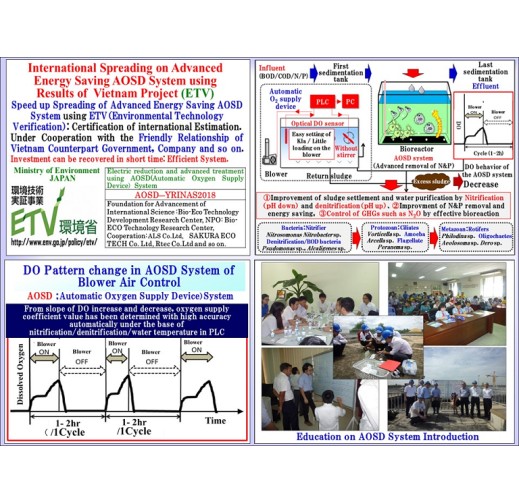Electric Reduction and Advanced Treatment using AOSD
Technology / Service Summary
The AOSD system enables the blower operation to be optimized and power consumption to be reduced. Biological nitrification/denitrification and dephosphorization reactions are enhanced, and removal of nitrogen and phosphorus in wastewater can be achieved. The device consists of luminescent dissolved oxygen (LDO)analyzer, programmable logic controller (PLC), and a computer. This is a multi-purpose technique for sewage water, industrial wastewater, and Johkaso (Not concentrated Domestic wastewater facilities). The optimum control system works similarly at water temperatures in frigid zones at 10°C and tropical zones above 30°C, and the power used for wastewater treatment was reduced(20-70%). This can therefore be applied internationally.
Purpose
The Purpose is to achieve international environmental restoration and climate change control through advanced wastewater treatment and automatic power reduction blower control technology.
Feature
Using the same water temperature and raw water concentration (BOD: 200 mg/L, total nitrogen: 45 mg/L, total phosphorus: 5 mg/L) as the evaluated performance of Domestic wastewater facilities in the Building Center of Japan, the optimum conditions for the treated water quality and reduction in power consumption were obtained in the Bio-Eco Engineering Research Laboratory in the National Institute for Environmental Studies, Japan. Also, based on the experimental results, it was decided to locate the LDO electrodes at the final tank if multiple tanks are present, and relatively good performance was obtained with the fixed bed intermittent aeration treatment. It was also shown that in the AOSD and membrane separation systems, by utilizing the air quantity for effective membrane cleaning, advanced treatment and approximately 70% reduction in power consumption were possible. In other words, this is a multi-Purpose technique for sewage water, industrial wastewater, and Johkaso (Not concentrated Domestic wastewater facilities).
Effect
This innovative technique not only protects the environment by purifying the effluent quality to BOD less than 10 mg/L, total nitrogen less than 10 mg/L, total phosphorus less than 1 mg/L and neutralizing its pH for restoring the environment and conserving natural water areas in an energy-efficient way using less power. As a result, the optimum control system works similarly at water temperatures in frigid zones at 10°C and tropical zones above 30°C, and the power used for wastewater treatment was reduced(20-70%). This can therefore be applied internationally.
Controlled Substance
Reference
Applicable Regions / Countries
- Japan
- Southeast Asia
- Central/South Asia
- China/ East Asia
- Middle East
- Africa
- Oceania
- Europe
- Central/South America
- ASEAN countries
Indonesia,Cambodia,Singapore,Thailand,Philippines,Brunei Darussalam,Viet Nam,Malaysia,Myanmar,Lao PDR
Accomplishments
In Vietnam, the AOSD system has been introduced for sewage treatment plants, food factory wastewater treatment facilities, and industrial park wastewater treatment facilities. As a result, it was demonstrated that both advanced wastewater treatment and power reduction are compatible.
Related SDGs Goals
- 6. Clean Water and Sanitation
- 7. Affordable and Clean Energy
- 9. Industry, Innovation and Infrastructure
- 11. Sustainable Cities and Communities
- 13. Climate Action



